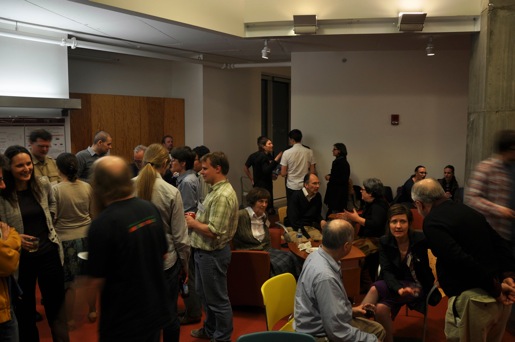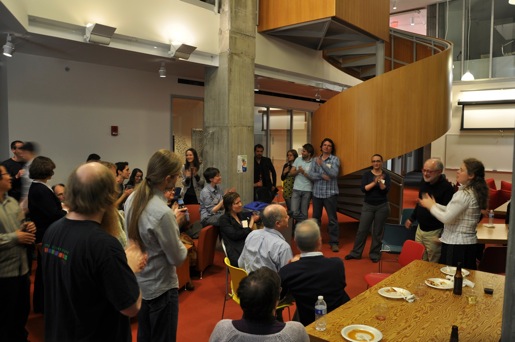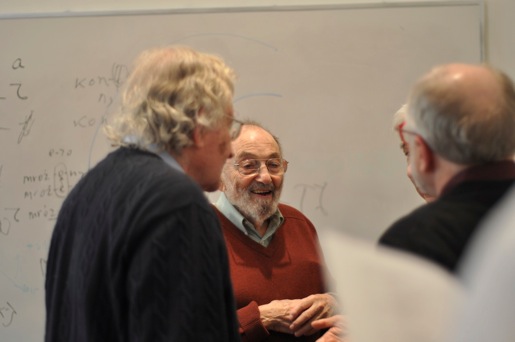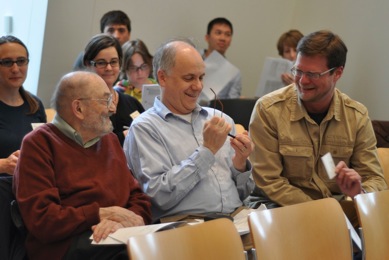Jessica Coon (PhD 2010), who we earlier announced has accepted a tenure-track Assistant Professor position at McGill University, has also been awarded a Banting Post-Doctoral Fellowship, which will allow her to begin her career at McGill with two years devoted mainly to research. Described informally by a colleague as “the Nobel prize of post-docs”, the goal of the Banting fellowship program is “to attract and retain top-tier postdoctoral talent, both nationally and internationally, to develop their leadership potential and to position them for success as research leaders of tomorrow”. As a Banting Fellow, Jessica will be collaborating with McGill’s Lisa Travis (MIT PhD 1984) on an investigation of an array of surprising syntactic parallels between Mayan and Austronesian languages. Congratulations Jessica!
Archive for May, 2011
Semester Wrap-Up
- Graduate student Patrick Jones gave a talk entitled “Tonal Opacity and Paradigm Structure in the Kinande Verb System” at the 19th Manchester Phonology Meeting, held May 19-21 at the University of Manchester.
- Faculty member Martin Hackl was at the University of Vienna as an invited speaker for the Identity in Grammar workshop at GLOW 34, the annual meeting of the organization Generative Linguistics in the Old World.
- At the end of last week, Jonah Katz (PhD 2010) and David Pesetsky presented some of their joint work on the syntax of music at a two-day conference on Music and Language in the Brain at the University of Aarhus, Denmark.
- This summer, 4th-year student Claire Halpert will be teaching a course on syntactic field methods at the second African Linguistics School, to be held in Porto Novo, Benin, July 17-31, before heading to South Africa to continue her research on Zulu. In addition, Claire and 5th year student Patrick Jones will both be presenting talks at the 42nd Annual Conference on African Linguistics (ACAL 42) at the University of Maryland. Patrick will be speaking about “Tonal Opacity and Paradigm Structure in the Kinande Verb System”, and Claire’s talk will concern Low Subjects in Zulu and the Prosody-Syntax Interface.
- Graduate student Patrick Jones gave a talk entitled “Tonal Opacity and Paradigm Structure in the Kinande Verb System” at the 19th Manchester Phonology Meeting, held May 19-21 at the University of Manchester.
- Faculty member Martin Hackl was at the University of Vienna as an invited speaker for the Identity in Grammar workshop at GLOW 34, the annual meeting of the organization Generative Linguistics in the Old World.
- At the end of last week, Jonah Katz (PhD 2010) and David Pesetsky presented some of their joint work on the syntax of music at a two-day conference on Music and Language in the Brain at the University of Aarhus, Denmark.
- This summer, 4th-year student Claire Halpert will be teaching a course on syntactic field methods at the second African Linguistics School, to be held in Porto Novo, Benin, July 17-31, before heading to South Africa to continue her research on Zulu. In addition, Claire and 5th year student Patrick Jones will both be presenting talks at the 42nd Annual Conference on African Linguistics (ACAL 42) at the University of Maryland. Patrick will be speaking about “Tonal Opacity and Paradigm Structure in the Kinande Verb System”, and Claire’s talk will concern Low Subjects in Zulu and the Prosody-Syntax Interface.
Our graduating linguistics majors!
Linguistics majors and double-majors Alyssa Kersting, Anna Goldie and Rafael Raya will all be receiving their S.B next week. Congratulations to all!!
Linguistics majors and double-majors Alyssa Kersting, Anna Goldie and Rafael Raya will all be receiving their S.B next week. Congratulations to all!!
Summer Pause
This is the last issue of this academic year. Whamit! will resume publication on Tuesday, Sept 6.
Have a nice summer!
This is the last issue of this academic year. Whamit! will resume publication on Tuesday, Sept 6.
Have a nice summer!
A grand “stepping down” bash to honor Department head Irene Heim
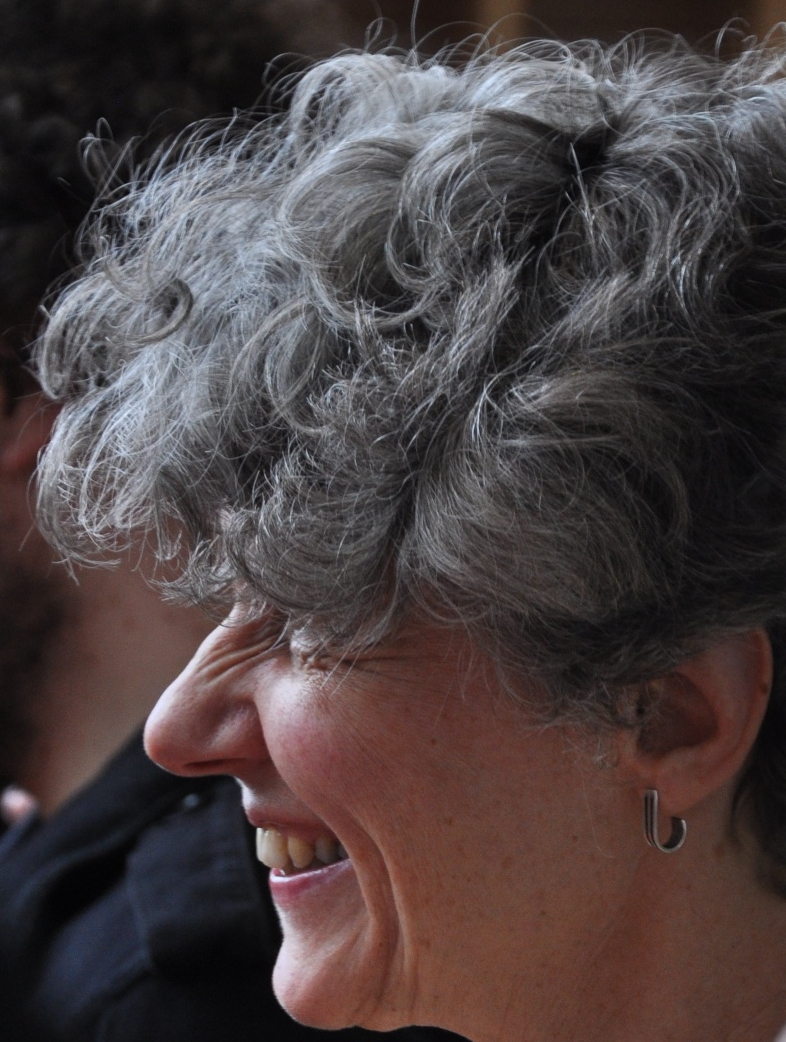
To celebrate Irene’s outstanding achievements as Head of the Department of Linguistics and Philosophy for the past three years (which followed three great years as Section Head of Linguistics), the department threw a spectacular gala party last Monday.

Irene’s work as section head was lauded by Dean Deborah Fitzgerald, incoming department head Richard Holton, incoming linguistics section head David Pesetsky and the department Administrative Officer Mary Grenham — as well as by several tons of great food and a big cake.

The party had a “gardening theme” (there were smoked salmon treats in edible spades) and Irene received several presents from a grateful department, including the traditional Bosch 1617EVSPK 12 Amp 2-1/4-Horsepower Plunge and Fixed Base Variable Speed Router Kit with 1/4-Inch and 1/2-Inch Collets, without which no term as department head could be complete. (Spies told us that this is what Irene most wanted!)
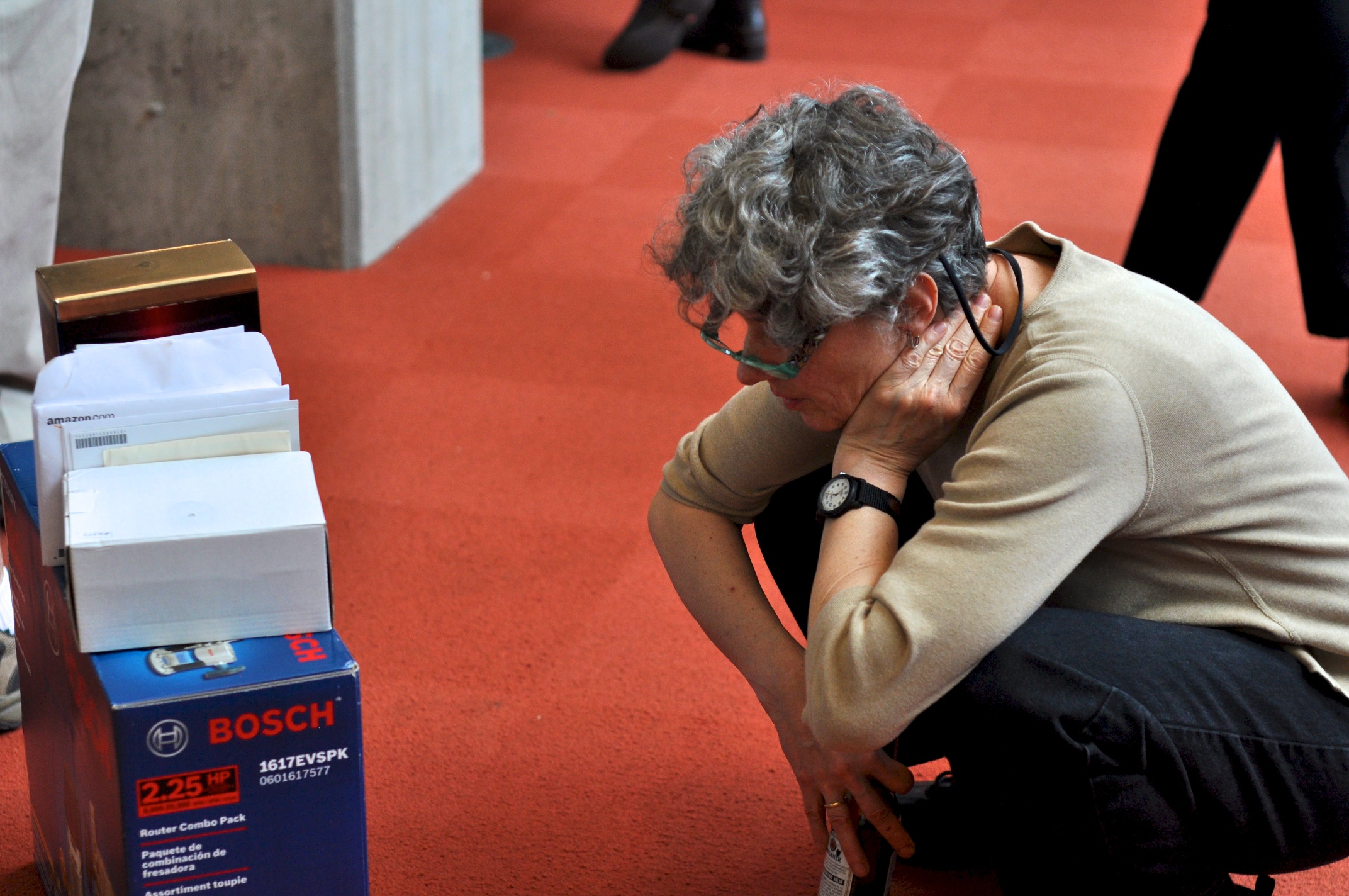
But the most memorable laudatio, and the culmination of the grand event, was provided by a band of linguistically minded ukulele players who wandered in off the street and decided to play for us on the spur of the moment:
L to R: Iain Giblin, Sam Steddy, Coppe van Urk, mitcho Erlewine, Edwin Howard
photo credits: mitcho Erlewine & Hrayr Khanjian

To celebrate Irene’s outstanding achievements as Head of the Department of Linguistics and Philosophy for the past three years (which followed three great years as Section Head of Linguistics), the department threw a spectacular gala party last Monday. 
Irene’s work as section head was lauded by Dean Deborah Fitzgerald, incoming department head Richard Holton, incoming linguistics section head David Pesetsky and the department Administrative Officer Mary Grenham — as well as by several tons of great food and a big cake.

The party had a “gardening theme” (there were smoked salmon treats in edible spades) and Irene received several presents from a grateful department, including the traditional Bosch 1617EVSPK 12 Amp 2-1/4-Horsepower Plunge and Fixed Base Variable Speed Router Kit with 1/4-Inch and 1/2-Inch Collets, without which no term as department head could be complete. (Spies told us that this is what Irene most wanted!)

But the most memorable laudatio, and the culmination of the grand event, was provided by a band of linguistically minded ukulele players who wandered in off the street and decided to play for us on the spur of the moment:
L to R: Iain Giblin, Sam Steddy, Coppe van Urk, mitcho Erlewine, Edwin Howard
photo credits: mitcho Erlewine & Hrayr Khanjian
Formal Approaches to Slavic Linguistics (FASL 20) a success!
The department was proud to host the 20th meeting of Formal Approaches to Slavic Linguistics (FASL). The conference, which ran from May 13-15, was a resounding success, drawing linguists from 13 countries and 3 continents to MIT. The presentations included invited talks by four of MIT’s own: professors Donca Steriade and Morris Halle (who was introduced by Noam Chomsky), visiting professor Sergei Tatevosov from Moscow State University, and recent alum Ivona Ku?erová (now at McMaster University in London, Ontario). Thanks to all presenters, attendees, and organizers for making FASL 20 such a success!
The department was proud to host the 20th meeting of Formal Approaches to Slavic Linguistics (FASL). The conference, which ran from May 13-15, was a resounding success, drawing linguists from 13 countries and 3 continents to MIT. The presentations included invited talks by four of MIT’s own: professors Donca Steriade and Morris Halle (who was introduced by Noam Chomsky), visiting professor Sergei Tatevosov from Moscow State University, and recent alum Ivona Ku?erová (now at McMaster University in London, Ontario). Thanks to all presenters, attendees, and organizers for making FASL 20 such a success!
A champion of Creole
The MIT News Office had a great article about Michel DeGraff last week: “A champion of Creole”.
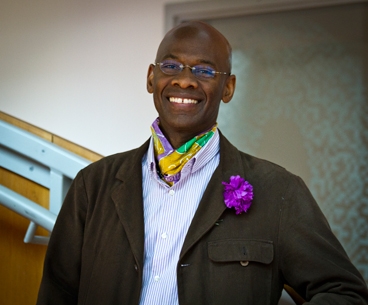
The MIT News Office had a great article about Michel DeGraff last week: “A champion of Creole”.

Workshop honouring Jean-Roger Vergnaud
Pritty Patel-Grosz reports:
A few months ago we were saddened to hear that Jean-Roger Vergnaud (MIT class of 1974) passed away. Last week (May 5th-7th), there was a workshop at USC honouring his work, called “Parallel Domains: Locality in syntax/phonology and the representation of constituency.” The program can be found here.
Past/present members of the MIT linguistics community who participated include:
- Noam Chomsky (Emeritus MIT professor) keynote speaker
- Bill Idsardi (MIT class of 1992) main session talk
- Julie Legate (MIT class of 2002) main session talk, member of the panel discussion
- Rita Manzini (MIT class of 1984) main session talk
- Pritty Patel-Grosz (current MIT student) main session talk
- Carson Schuetze (MIT class of 1997) main session talk
- Dominique Sportiche (MIT class of 1984) invited talk
Pritty Patel-Grosz reports:
A few months ago we were saddened to hear that Jean-Roger Vergnaud (MIT class of 1974) passed away. Last week (May 5th-7th), there was a workshop at USC honouring his work, called “Parallel Domains: Locality in syntax/phonology and the representation of constituency.” The program can be found here.
Past/present members of the MIT linguistics community who participated include:
- Noam Chomsky (Emeritus MIT professor) keynote speaker
- Bill Idsardi (MIT class of 1992) main session talk
- Julie Legate (MIT class of 2002) main session talk, member of the panel discussion
- Rita Manzini (MIT class of 1984) main session talk
- Pritty Patel-Grosz (current MIT student) main session talk
- Carson Schuetze (MIT class of 1997) main session talk
- Dominique Sportiche (MIT class of 1984) invited talk
Syntax/Semantics Square 5/9 - Robert Henderson
Speaker: Robert Henderson (UCSC)
Title: A corpus-based approach to quantifier scope disambiguation
Time: Monday, May 9, 11:30am
Location: 32-D461
(Joint work with Scott AnderBois and Adrian Brasoveanu)
Most investigations of quantifier scope are concerned with the range of possible scopes for sentences with multiple quantifiers. Instead, this study examines the actual scopes, i.e., the pragmatics of quantifier scope disambiguation. Although actual usage facts fall outside of semantics proper, we are interested in them because they too are facts about natural language interpretation. Moreover, they are facts which provide indirect evidence about the semantics of quantifiers, e.g. if “some” has a stronger preference for narrow scope than “a”, then their semantic representations should arguably be different. To address these questions, we assembled a corpus of sentences from LSAT logic puzzles and tagged it for quantifier scope. In this talk I’ll present our corpus and compare several models of quantifier scope disambiguation.
Speaker: Robert Henderson (UCSC)
Title: A corpus-based approach to quantifier scope disambiguation
Time: Monday, May 9, 11:30am
Location: 32-D461
(Joint work with Scott AnderBois and Adrian Brasoveanu)
Most investigations of quantifier scope are concerned with the range of possible scopes for sentences with multiple quantifiers. Instead, this study examines the actual scopes, i.e., the pragmatics of quantifier scope disambiguation. Although actual usage facts fall outside of semantics proper, we are interested in them because they too are facts about natural language interpretation. Moreover, they are facts which provide indirect evidence about the semantics of quantifiers, e.g. if “some” has a stronger preference for narrow scope than “a”, then their semantic representations should arguably be different. To address these questions, we assembled a corpus of sentences from LSAT logic puzzles and tagged it for quantifier scope. In this talk I’ll present our corpus and compare several models of quantifier scope disambiguation.
BCS Cog Lunch 5/10 - Melissa Kline
Speaker: Melissa Kline
Title: Children’s comprehension and production of transitive sentences is sensitive to the causal structure of events
Time: Tuesday 5/10, 46-3189, 12-1pm
Young children learn about causal relationships not only from observation, but also from the language they hear. Two novel-verb studies show that preschoolers recognize that transitive sentences like `Sarah broke the lamp’ express a relationship between cause and effect. Previous work has explored only differences between prototypical events of different categories, systematically conflating causation with a number of other semantic features. The present studies show that children attend specifically to causal structure, as indicated by spatiotemporal contiguity between action and outcome subevents. Children were more likely to give transitive descriptions (‘She wugged it’) to causal than to noncausal versions of an event. Children also reliably selected a causal event when asked to ‘find where she wugged [it].’ Transitive sentences thus provide children with a rich source of evidence about the verbs they learn and the events they encounter in the world.
Speaker: Melissa Kline
Title: Children’s comprehension and production of transitive sentences is sensitive to the causal structure of events
Time: Tuesday 5/10, 46-3189, 12-1pm
Young children learn about causal relationships not only from observation, but also from the language they hear. Two novel-verb studies show that preschoolers recognize that transitive sentences like `Sarah broke the lamp’ express a relationship between cause and effect. Previous work has explored only differences between prototypical events of different categories, systematically conflating causation with a number of other semantic features. The present studies show that children attend specifically to causal structure, as indicated by spatiotemporal contiguity between action and outcome subevents. Children were more likely to give transitive descriptions (‘She wugged it’) to causal than to noncausal versions of an event. Children also reliably selected a causal event when asked to ‘find where she wugged [it].’ Transitive sentences thus provide children with a rich source of evidence about the verbs they learn and the events they encounter in the world.
MIT News Article about Wayne O’Neil
“Looking beyond English: MIT professor uses linguistics in an ESL classroom to teach scientific principles, empower a new generation of critical thinkers” is a nice article about Wayne O’Neil and Maya Honda’s work with linguistics in high schools.
“Looking beyond English: MIT professor uses linguistics in an ESL classroom to teach scientific principles, empower a new generation of critical thinkers” is a nice article about Wayne O’Neil and Maya Honda’s work with linguistics in high schools.
Phonology Circle 5/10 - RUMMIT Practice Talks
The last regularly scheduled Phonology Circle for the semester will feature practice talks for RUMMIT (which will take place at Rutgers on Mon 5/16):
Speaker: Coppe van Urk
Title: On the distribution of clashes
Speaker: Suyeon Yun
Title: String-based domains of duration preservation
Time: Tuesday 5/10, 5-6pm, 32-D831
You can view the current, up-to-date version of the schedule here (click ‘agenda’ to see the schedule as a list), or subscribe via iCal here.
The last regularly scheduled Phonology Circle for the semester will feature practice talks for RUMMIT (which will take place at Rutgers on Mon 5/16):
Speaker: Coppe van Urk
Title: On the distribution of clashes
Speaker: Suyeon Yun
Title: String-based domains of duration preservation
Time: Tuesday 5/10, 5-6pm, 32-D831
You can view the current, up-to-date version of the schedule here (click ‘agenda’ to see the schedule as a list), or subscribe via iCal here.
RUMMIT II at Rutgers - Mon 5/16
RUMMIT, the semesterly meeting of phonologists from Rutgers, UMass, and MIT will be held at Rutgers on May 16, 2011, from 11am - 5pm.
A schedule and directions can be found here.
RUMMIT, the semesterly meeting of phonologists from Rutgers, UMass, and MIT will be held at Rutgers on May 16, 2011, from 11am - 5pm.
A schedule and directions can be found here.
LFRG 5/11 and 5/13 - Ciro Greco + SALT practice talks
There will be two meetings of the LFRG next week.
WHO: Ciro Greco
WHAT: Double Access Reading
WHEN: May 11, 5:00PM-6:30PM (note the unusual time)
WHERE: 32-D831
ABSTRACT:
In many languages, when a present tense stative predicate is embedded under a past tense attitude verb we observe a particular temporal interpretation of the sentence know as Double Access Reading (DAR). In particular, the embedded eventuality must be interpreted as temporally overlapping both the attitude’s time and the utterance time:
(1) Ezra ha detto che Frida è incinta.
Ezra said that Frida is pregnant
The present tense in (1) seems to be sensitive both to the matrix tense and to the utterance time. Many scholars claimed that DAR is a consequence of a core property of temporal dependencies, namely that tenses in embedded attitude contexts cannot take their denotation only with respect to the utterance time (Enç 1987, Higginbotham 1995, Giorgi 2010). Therefore, tenses in embedded attitude contexts cannot be interpreted as mere indexicals.
However, in the following example, the present tense need not to be interpreted as to the matrix time; the crucial point is the overlapping with the utterance time. Prima facie, (2) represent a problem for the generalization above:
(2) Ezra ha detto che Frida è a casa oggi.
Ezra said that Frida is at home today.
Although (2) seem to show that there are cases in which an embedded tense can be interpreted as a mere indexical, we will argue that this kind of examples do not represent a real counterexample to a theory of DAR. Our aim is to show that these cases can be accounted for using a semantics of futurates along the lines of Copley (2009).
WHAT: SALT practice talks
WHEN: Friday 5/13, 2pm (the usual time)
WHERE: 32-D831
There will be two meetings of the LFRG next week.
WHO: Ciro Greco
WHAT: Double Access Reading
WHEN: May 11, 5:00PM-6:30PM (note the unusual time)
WHERE: 32-D831
ABSTRACT:
In many languages, when a present tense stative predicate is embedded under a past tense attitude verb we observe a particular temporal interpretation of the sentence know as Double Access Reading (DAR). In particular, the embedded eventuality must be interpreted as temporally overlapping both the attitude’s time and the utterance time:
(1) Ezra ha detto che Frida è incinta.
Ezra said that Frida is pregnantThe present tense in (1) seems to be sensitive both to the matrix tense and to the utterance time. Many scholars claimed that DAR is a consequence of a core property of temporal dependencies, namely that tenses in embedded attitude contexts cannot take their denotation only with respect to the utterance time (Enç 1987, Higginbotham 1995, Giorgi 2010). Therefore, tenses in embedded attitude contexts cannot be interpreted as mere indexicals.
However, in the following example, the present tense need not to be interpreted as to the matrix time; the crucial point is the overlapping with the utterance time. Prima facie, (2) represent a problem for the generalization above:
(2) Ezra ha detto che Frida è a casa oggi.
Ezra said that Frida is at home today.Although (2) seem to show that there are cases in which an embedded tense can be interpreted as a mere indexical, we will argue that this kind of examples do not represent a real counterexample to a theory of DAR. Our aim is to show that these cases can be accounted for using a semantics of futurates along the lines of Copley (2009).
WHAT: SALT practice talks
WHEN: Friday 5/13, 2pm (the usual time)
WHERE: 32-D831
Formal Approaches to Slavic Linguistics 20@MIT, Friday, 5/13- Sunday, 5/15

This Friday through Sunday, May 13-15, MIT Linguistics will host the 20th anniversary meeting of Formal Approaches to Slavic Linguistics (FASL). During the three days of the conference, almost 30 talks (including several plenary lectures) will be presented by Slavic linguists from a dozen different countries. In the two decades since the very first FASL was organized by Jindrich Toman at the University of Michigan twenty years ago, the conference has become one of the major venues for reporting research on the structure of all the Slavic languages. FASL has also served as an inspiration for similarly-themed conferences for other languages areas such as AFLA for Austronesian and FAMLi for Mayan. The second meeting of FASL (which cemented its status as an annual event) was held here at MIT, where it was co-organized by Sergey Avrutin and by Masha Babyonyshev, to whose memory this twentieth-anniversary conference will be dedicated. The FASL talks will span all areas of Slavic formal linguistics: syntax, semantics, morphology and phonology.
So welcome to, ????? ?????????? ?, vitajte na, ????????????? ??, vitejte na, dobrodošli na, witamy na, ??????? ??????? ??, ????? ????? ?, & witaj?e k…FASL! See you there!

This Friday through Sunday, May 13-15, MIT Linguistics will host the 20th anniversary meeting of Formal Approaches to Slavic Linguistics (FASL). During the three days of the conference, almost 30 talks (including several plenary lectures) will be presented by Slavic linguists from a dozen different countries. In the two decades since the very first FASL was organized by Jindrich Toman at the University of Michigan twenty years ago, the conference has become one of the major venues for reporting research on the structure of all the Slavic languages. FASL has also served as an inspiration for similarly-themed conferences for other languages areas such as AFLA for Austronesian and FAMLi for Mayan. The second meeting of FASL (which cemented its status as an annual event) was held here at MIT, where it was co-organized by Sergey Avrutin and by Masha Babyonyshev, to whose memory this twentieth-anniversary conference will be dedicated. The FASL talks will span all areas of Slavic formal linguistics: syntax, semantics, morphology and phonology.
So welcome to, ????? ?????????? ?, vitajte na, ????????????? ??, vitejte na, dobrodošli na, witamy na, ??????? ??????? ??, ????? ????? ?, & witaj?e k…FASL! See you there!
Ling-Lunch 5/12 - Bronwyn Bjorkman
Speaker: Bronwyn Bjorkman
Title: The crosslinguistic defaultness of be
Time: Thursday, May 12, 12:30-1:45pm
Location: 32-D461
In this talk I propose that auxiliaries such as be are a morphological strategy for realizing verbal inflection that has been “stranded” by the syntactic derivation. This is an alternative to the view that auxiliaries head dedicated projections idiosyncratically subcategorized for in particular inflectional contexts. I argue that viewing auxiliary verbs as morphological defaults allows us to unify two superficially different patterns of auxiliary use: a pattern like the one we find in English, where auxiliary-taking categories always occur with an auxiliary (i.e. the passive and progressive), and a pattern that we find in languages like Latin and Kinande (Bantu) (among other languages), where auxiliaries only arise in certain combinations of categories. Kinande, for example, has synthetic past tense and progressive forms, but requires an auxiliary to express both at once (the past progressive). In addition to developing a model of verbal inflection that can account for both these patterns, I discuss some implications of the approach for inflectional marking in counterfactuals.
Speaker: Bronwyn Bjorkman
Title: The crosslinguistic defaultness of be
Time: Thursday, May 12, 12:30-1:45pm
Location: 32-D461
In this talk I propose that auxiliaries such as be are a morphological strategy for realizing verbal inflection that has been “stranded” by the syntactic derivation. This is an alternative to the view that auxiliaries head dedicated projections idiosyncratically subcategorized for in particular inflectional contexts. I argue that viewing auxiliary verbs as morphological defaults allows us to unify two superficially different patterns of auxiliary use: a pattern like the one we find in English, where auxiliary-taking categories always occur with an auxiliary (i.e. the passive and progressive), and a pattern that we find in languages like Latin and Kinande (Bantu) (among other languages), where auxiliaries only arise in certain combinations of categories. Kinande, for example, has synthetic past tense and progressive forms, but requires an auxiliary to express both at once (the past progressive). In addition to developing a model of verbal inflection that can account for both these patterns, I discuss some implications of the approach for inflectional marking in counterfactuals.
Syntax Square 5/2 - Kirill Shklovsky
Time: Monday, May 2, 11:30am
Location: 32-D461
Kirill Shklovsky will be discussing Elena Anagnostopoulou’s “The Syntax of Ditransitives.”
Time: Monday, May 2, 11:30am
Location: 32-D461
Kirill Shklovsky will be discussing Elena Anagnostopoulou’s “The Syntax of Ditransitives.”
Phonology Circle 5/3 - Nina Topintzi
Speaker: Nina Topintzi
Title: The (morpho)phonology of the Greek glide and the palatals
Time: Tuesday 5/3, 5-6pm, 32-D831
The glide [j] has been notorious in the Greek literature as a segment whose nature alternates in complex ways between that of an allophone of /i/ as well as of a phoneme distinct from it. Past accounts have managed to capture a fairly limited set of the data, most frequently by making recourse to historical or sociolinguistic factors. The aim of this talk is to improve on this situation by analysing a wider set of facts and by promoting the role pure grammatical factors play. The first part of the talk offers a proposal for the glide which attempts to elucidate its various facets uniformly with the added bonus that it can extend to an analysis of palatals (also problematic in the literature). In the second part, I present a first take on the behaviour of the glide in various morpho-phonological environments. It will become obvious that while the preceding analysis works satisfactorily for a large part of the data, a lot remains to be understood.
Upcoming talks:
May 10: RUMMIT practice talks
You can view the current, up-to-date version of the schedule here (click ‘agenda’ to see the schedule as a list), or subscribe via iCal here.
Speaker: Nina Topintzi
Title: The (morpho)phonology of the Greek glide and the palatals
Time: Tuesday 5/3, 5-6pm, 32-D831
The glide [j] has been notorious in the Greek literature as a segment whose nature alternates in complex ways between that of an allophone of /i/ as well as of a phoneme distinct from it. Past accounts have managed to capture a fairly limited set of the data, most frequently by making recourse to historical or sociolinguistic factors. The aim of this talk is to improve on this situation by analysing a wider set of facts and by promoting the role pure grammatical factors play. The first part of the talk offers a proposal for the glide which attempts to elucidate its various facets uniformly with the added bonus that it can extend to an analysis of palatals (also problematic in the literature). In the second part, I present a first take on the behaviour of the glide in various morpho-phonological environments. It will become obvious that while the preceding analysis works satisfactorily for a large part of the data, a lot remains to be understood.
Upcoming talks:
May 10: RUMMIT practice talks
You can view the current, up-to-date version of the schedule here (click ‘agenda’ to see the schedule as a list), or subscribe via iCal here.
Special Phonology Circle-Thurs 5/5- Shin Ishihara
Speaker: Shin Ishihara
Title: Japanese Focus Prosody Revisited: Freeing Focus from Prosodic Phrasing
Time: Thurs 5/5, 11am-12pm, 32-D461 ***NOTE SPECIAL DATE, TIME, AND LOCATION
This talk revisits empirical and theoretical problems of focus prosody
in Japanese, and proposes a new analysis. Contrary to the widely
accepted assumption that focus directly or indirectly modifies
prosodic phrasing, various studies have shown that prosodic boundaries
remain unchanged when a focus is added to a sentence. It is proposed
that phonetic effects of focus (F0-rise on the focused word, and
reduction in the post-focal areas) result from manipulations of
metrical prominences (addition of focal prominence on the focused word
and deletion of head prominences in the post-focal area) that have no
effect on prosodic boundaries. In order to allow prominence
manipulation while keeping prosodic phrasing intact, two modifications
are made to one of the widely accepted Optimality-Theoretic analyses
of focus prosody. First, the syntax-prosody alignment constraint will
be ranked higher, which allows it to dictate the location of prosodic
boundaries. Second, metrical culminativity (one metrical prominence
per prosodic constituent) is treated as a violable constraint, and it
is proposed that this constraint is low-ranked in Japanese. As a
result, Japanese allows multi-headed phrases (when focus adds a
prominence), as well as headless prosodic phrases (when focus deletes
post-focal prominences).
Speaker: Shin Ishihara
Title: Japanese Focus Prosody Revisited: Freeing Focus from Prosodic Phrasing
Time: Thurs 5/5, 11am-12pm, 32-D461 ***NOTE SPECIAL DATE, TIME, AND LOCATION
This talk revisits empirical and theoretical problems of focus prosody in Japanese, and proposes a new analysis. Contrary to the widely accepted assumption that focus directly or indirectly modifies prosodic phrasing, various studies have shown that prosodic boundaries remain unchanged when a focus is added to a sentence. It is proposed that phonetic effects of focus (F0-rise on the focused word, and reduction in the post-focal areas) result from manipulations of metrical prominences (addition of focal prominence on the focused word and deletion of head prominences in the post-focal area) that have no effect on prosodic boundaries. In order to allow prominence manipulation while keeping prosodic phrasing intact, two modifications are made to one of the widely accepted Optimality-Theoretic analyses of focus prosody. First, the syntax-prosody alignment constraint will be ranked higher, which allows it to dictate the location of prosodic boundaries. Second, metrical culminativity (one metrical prominence per prosodic constituent) is treated as a violable constraint, and it is proposed that this constraint is low-ranked in Japanese. As a result, Japanese allows multi-headed phrases (when focus adds a prominence), as well as headless prosodic phrases (when focus deletes post-focal prominences).
Ling-Lunch 5/5 - Marios Mavrogiorgos
Speaker: Marios Mavrogiorgos
Title: V-movement to a V-related head and enclisis: a view from finiteness sensitive and Tobler-Mussafia languages
Location: 32-D461
Time: Thursday, May 5, 12:30-1:45pm
The proclisis-enclisis alternation is found in most languages having clitic pronouns. One basic observation made by many researchers is that clitic languages can be distinguished into two basic types depending on whether finiteness plays a role in the alternation or not. In the literature there have been different analyses of enclisis. For example, we can find both syntactic and PF approaches either for finiteness sensitive languages or for non finiteness sensitive languages, or for both. However, most of the existent analyses face problems, and moreover it is not clear what underlies the basic distinction between the two language types. In this talk I will propose a unified analysis for both finiteness sensitive and non finiteness sensitive languages. My main claim will be that enclisis arises in both language types only when V moves across the cliticization site to a V-related head (in the sense of Chomksy 1993, Rizzi 1997). The finiteness factor will be reduced to impoverished person agreement that correlates with V-related features in a head higher than the cliticization site, which trigger V movement. The difference between the two language types wrt. to their sensitivity in finiteness will be accounted for as a difference in the spelled-out morphology of different types of V-related features in each language type: agr/mood features in finiteness sensitive languages/structures vs. affective features in non finiteness sensitive languages. Checking of V-related features in both language types will be argued to be subject to an economy principle which requires that the feature is checked by an overt element which is either a head or a spec. In this respect, two types of features will be distinguished: V-related features, which carry a PF-requirement and give rise to enclisis, and non V-related features, which do not carry a PF requirement and which correlate with proclisis. According to this distinction, enclisis is seen as morphological (re)ordering of V-related heads. A theoretical implementation of this basic intuition will be provided, and further typological and other issues will be discussed.
Speaker: Marios Mavrogiorgos
Title: V-movement to a V-related head and enclisis: a view from finiteness sensitive and Tobler-Mussafia languages
Location: 32-D461
Time: Thursday, May 5, 12:30-1:45pm
The proclisis-enclisis alternation is found in most languages having clitic pronouns. One basic observation made by many researchers is that clitic languages can be distinguished into two basic types depending on whether finiteness plays a role in the alternation or not. In the literature there have been different analyses of enclisis. For example, we can find both syntactic and PF approaches either for finiteness sensitive languages or for non finiteness sensitive languages, or for both. However, most of the existent analyses face problems, and moreover it is not clear what underlies the basic distinction between the two language types. In this talk I will propose a unified analysis for both finiteness sensitive and non finiteness sensitive languages. My main claim will be that enclisis arises in both language types only when V moves across the cliticization site to a V-related head (in the sense of Chomksy 1993, Rizzi 1997). The finiteness factor will be reduced to impoverished person agreement that correlates with V-related features in a head higher than the cliticization site, which trigger V movement. The difference between the two language types wrt. to their sensitivity in finiteness will be accounted for as a difference in the spelled-out morphology of different types of V-related features in each language type: agr/mood features in finiteness sensitive languages/structures vs. affective features in non finiteness sensitive languages. Checking of V-related features in both language types will be argued to be subject to an economy principle which requires that the feature is checked by an overt element which is either a head or a spec. In this respect, two types of features will be distinguished: V-related features, which carry a PF-requirement and give rise to enclisis, and non V-related features, which do not carry a PF requirement and which correlate with proclisis. According to this distinction, enclisis is seen as morphological (re)ordering of V-related heads. A theoretical implementation of this basic intuition will be provided, and further typological and other issues will be discussed.
LFRG 5/6 - Alan Bale
WHO: Alan Bale
WHAT: Singular, Plural, and Obligatory Competition
WHEN: May 6, 2:00PM-3:15PM
WHERE: 32-D831
ABSTRACT:
Several theories have proposed that number marking, in particular singular and plural marking, compete with one another and that this competition influences how nouns are interpreted. Evidence in support of this proposal usually comes from languages like English where singular nouns have a strict singular interpretation. In such languages, it is hypothesized that plural nouns are literally unspecified for number but receive a strict plural interpretation through (obligatory) competition with the singular (see Krifka, 1989; Spector, 2007; and Sauerland et al., 2005).
This talk investigates whether singular and plural marking in Turkish and Western Armenian compete with one another. Unlike English, the so-called singular nouns in these languages do not have a strict singular interpretation, but rather can be used to quantify over both groups and individuals. In contrast, the plural nouns have a strict plural interpretation. As will be shown, there is evidence of competition in these languages but such competition critically relies on a comparison of syntactic complexity. Such a conclusion has cross-linguistic consequences for all types of competition, especially with respect to number marking.
WHO: Alan Bale
WHAT: Singular, Plural, and Obligatory Competition
WHEN: May 6, 2:00PM-3:15PM
WHERE: 32-D831
ABSTRACT:
Several theories have proposed that number marking, in particular singular and plural marking, compete with one another and that this competition influences how nouns are interpreted. Evidence in support of this proposal usually comes from languages like English where singular nouns have a strict singular interpretation. In such languages, it is hypothesized that plural nouns are literally unspecified for number but receive a strict plural interpretation through (obligatory) competition with the singular (see Krifka, 1989; Spector, 2007; and Sauerland et al., 2005).
This talk investigates whether singular and plural marking in Turkish and Western Armenian compete with one another. Unlike English, the so-called singular nouns in these languages do not have a strict singular interpretation, but rather can be used to quantify over both groups and individuals. In contrast, the plural nouns have a strict plural interpretation. As will be shown, there is evidence of competition in these languages but such competition critically relies on a comparison of syntactic complexity. Such a conclusion has cross-linguistic consequences for all types of competition, especially with respect to number marking.
Language and the Human Mind - Open House
The department opened its doors to visitors last Saturday as part of the MIT-wide open house Under the Dome, and received a steady stream of visitors curious about our contribution, a series of activities under the theme “Language and the Human Mind”.
Visitors learned about a number of interesting languages, among them the Mayan languages of Central America, Uyghur and the Wampanoag language of the native inhabitants of Massachusetts. They viewed posters explaining recent research projects our graduate students and UROPs have undertaken, stepped into the Experimental Syntax & Semantics Lab to participate in psycholinguistic experiments designed to reveal how language interfaces with the conceptual-intentional systems of the mind, then hunkered down to solve linguistics puzzles about Mayan, with chocolate their reward for correct answers.
A selection of photos from the event (more here):
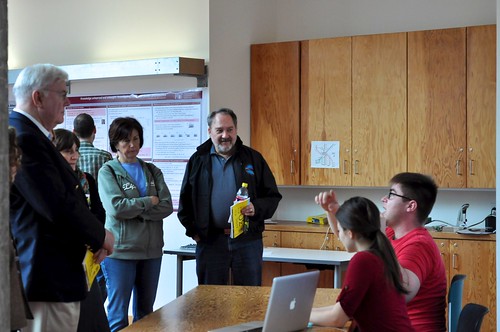
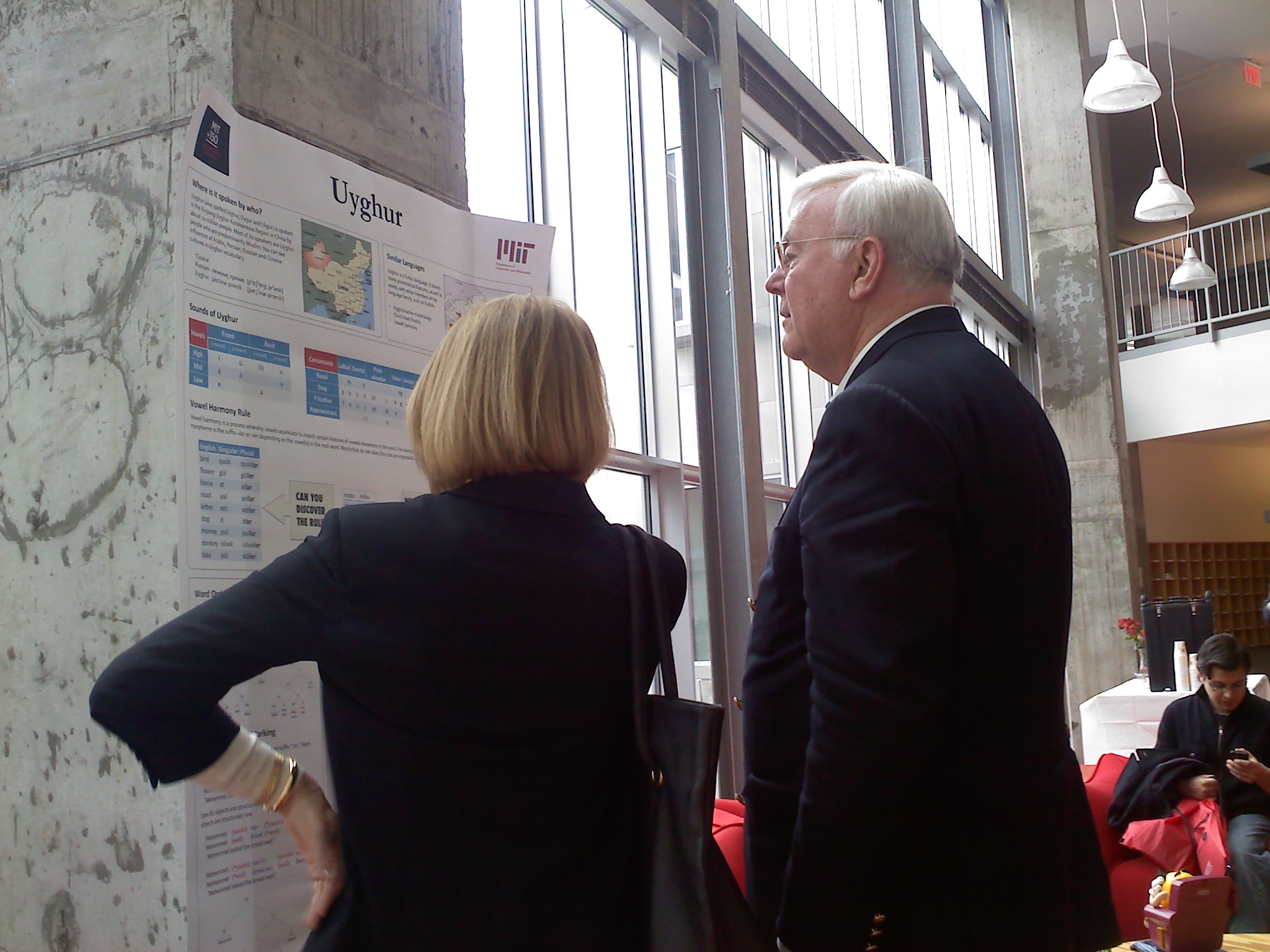
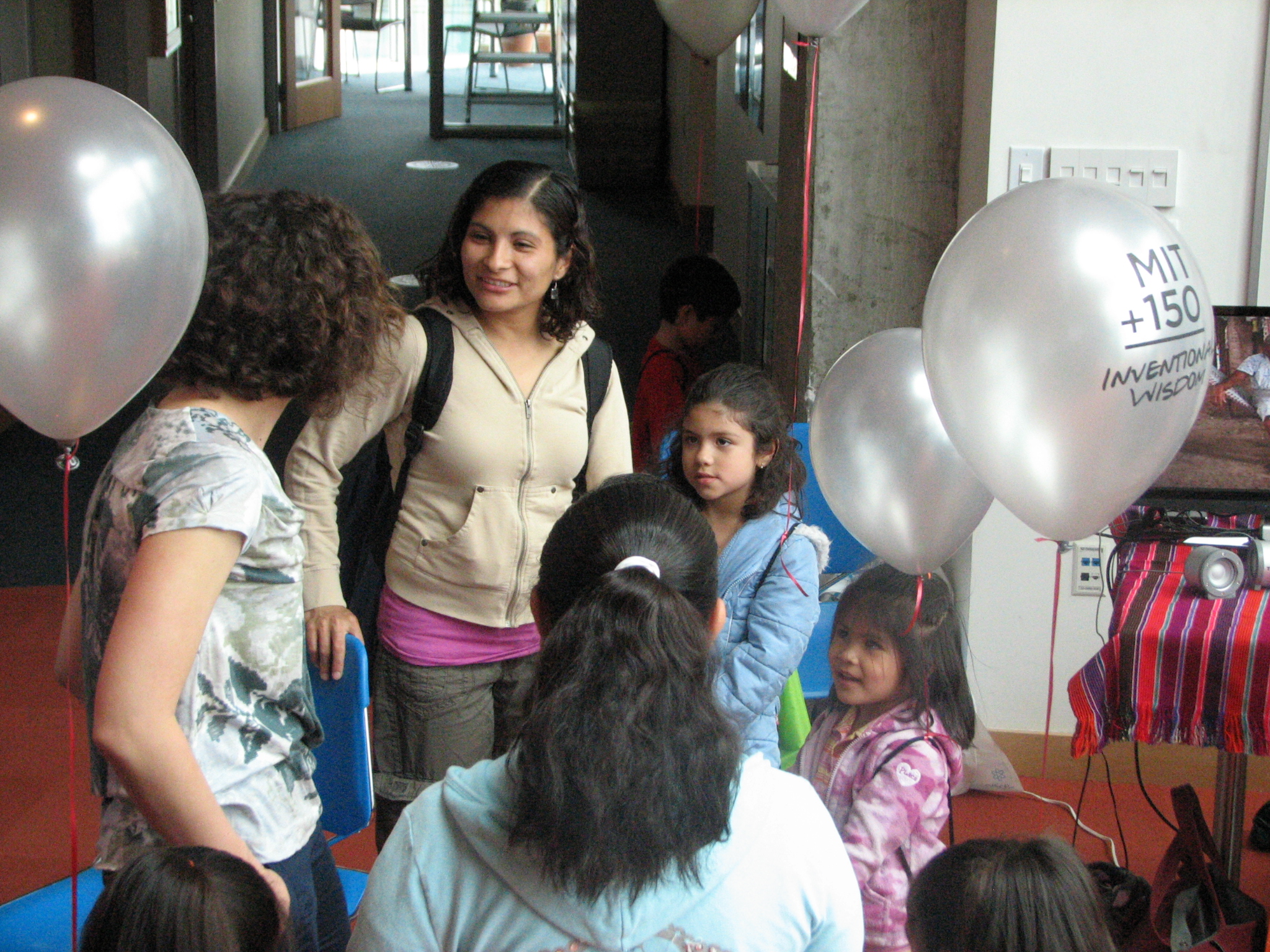
Thank you to all who participated in the open house and made it a success! Thanks also to Adam Albright, Micha Breakstone, Mitcho Erlewine, Jeremy Hartman and Kirill Shklovsky for reports and photographs.
The department opened its doors to visitors last Saturday as part of the MIT-wide open house Under the Dome, and received a steady stream of visitors curious about our contribution, a series of activities under the theme “Language and the Human Mind”.
Visitors learned about a number of interesting languages, among them the Mayan languages of Central America, Uyghur and the Wampanoag language of the native inhabitants of Massachusetts. They viewed posters explaining recent research projects our graduate students and UROPs have undertaken, stepped into the Experimental Syntax & Semantics Lab to participate in psycholinguistic experiments designed to reveal how language interfaces with the conceptual-intentional systems of the mind, then hunkered down to solve linguistics puzzles about Mayan, with chocolate their reward for correct answers.
A selection of photos from the event (more here):



Thank you to all who participated in the open house and made it a success! Thanks also to Adam Albright, Micha Breakstone, Mitcho Erlewine, Jeremy Hartman and Kirill Shklovsky for reports and photographs.
How one linguistics major will spend his summer vacation
MIT undergraduate linguistics (and math) major John Berman (class of 2013) will be heading to Chiapas, Mexico this summer with members of the Harvard Language Processing Lab (including recent graduate Jessica Coon), where he will help run an experiment on processing of relative clauses in the Tumbalá dialect of Chol. The experiment will investigate processing speeds of ergative and absolutive argument extraction in the language. After the rest of the lab group heads back to Cambridge, John will stay on for a month in a Chol-speaking village to continue his own work on the language.
MIT undergraduate linguistics (and math) major John Berman (class of 2013) will be heading to Chiapas, Mexico this summer with members of the Harvard Language Processing Lab (including recent graduate Jessica Coon), where he will help run an experiment on processing of relative clauses in the Tumbalá dialect of Chol. The experiment will investigate processing speeds of ergative and absolutive argument extraction in the language. After the rest of the lab group heads back to Cambridge, John will stay on for a month in a Chol-speaking village to continue his own work on the language.
Colloquium 5/6 - Shin Ishihara
Speaker: Shin Ishihara (J.W. Goethe-Universität, Frankfurt am Main)
Time: Friday, May 6, 2011, 3:30pm-5pm
Location: 32-141 (PLEASE NOTE THE ROOM)
Title: On the Clause-Mate Condition in Japanese: Implicit Prosody and
Argument Structure Parsing
Abstract:
In some syntactic constructions in Japanese, more than one constituent
can move together to a certain syntactic position. One example is the
cleft construction: Japanese clefts allow multiple constituents to
appear in the focus position (`It is x, y that … t(x) … t(y)…’).
It has often been claimed that such constituents must originate from
the same clause, i.e., they must be clause-mates (= the Clause-Mate
Condition, the CMC). This condition has often been analyzed as a
syntactic constraint that strictly bans any syntactic derivation
violating it. There are, however, cases where the CMC can be obviated.
For example, if the cleft sentence with multiple foci is a wh-question
(`Who(x), what(y) is it that … t(x) … t(y) …?’), the sentence
acceptability improves compared to its declarative counterpart. So
far, no account has been proposed that can explain both the CMC and
the CMC obviation cases.
In this talk, I claim that the Clause-Mate Condition in Japanese is
not a syntactic constraint, and propose that the CMC effect comes from
the influence of `implicit prosody’ on sentence parsing. Adopting the
Implicit Prosody Hypothesis (Fodor 1998, 2002), I will propose a
parsing principle which imposes a certain bias on the argument
structure comprehension according to the prosodic phrasing in the
implicit prosody. This analysis can explain both the CMC effect in
clefts with multiple focus constituents and its obviation effect under
certain conditions (including interrogatives) in a parallel fashion.
The analysis also makes further predictions on potential parsing
difficulties in other constructions such as long-distance scrambling.
It will be suggested that some of the mysterious restrictions found in
long-distance scrambling in Japanese (e.g., ban on long-distance
scrambling to a sentence-medial position, ban on scrambling of
nominative subjects) are related to the parsing difficulty caused by
the implicit prosody.
Speaker: Shin Ishihara (J.W. Goethe-Universität, Frankfurt am Main)
Time: Friday, May 6, 2011, 3:30pm-5pm
Location: 32-141 (PLEASE NOTE THE ROOM)
Title: On the Clause-Mate Condition in Japanese: Implicit Prosody and
Argument Structure Parsing
Abstract:
In some syntactic constructions in Japanese, more than one constituent can move together to a certain syntactic position. One example is the cleft construction: Japanese clefts allow multiple constituents to appear in the focus position (`It is x, y that … t(x) … t(y)…’). It has often been claimed that such constituents must originate from the same clause, i.e., they must be clause-mates (= the Clause-Mate Condition, the CMC). This condition has often been analyzed as a syntactic constraint that strictly bans any syntactic derivation violating it. There are, however, cases where the CMC can be obviated. For example, if the cleft sentence with multiple foci is a wh-question (`Who(x), what(y) is it that … t(x) … t(y) …?’), the sentence acceptability improves compared to its declarative counterpart. So far, no account has been proposed that can explain both the CMC and the CMC obviation cases.
In this talk, I claim that the Clause-Mate Condition in Japanese is not a syntactic constraint, and propose that the CMC effect comes from the influence of `implicit prosody’ on sentence parsing. Adopting the Implicit Prosody Hypothesis (Fodor 1998, 2002), I will propose a parsing principle which imposes a certain bias on the argument structure comprehension according to the prosodic phrasing in the implicit prosody. This analysis can explain both the CMC effect in clefts with multiple focus constituents and its obviation effect under certain conditions (including interrogatives) in a parallel fashion.
The analysis also makes further predictions on potential parsing difficulties in other constructions such as long-distance scrambling. It will be suggested that some of the mysterious restrictions found in long-distance scrambling in Japanese (e.g., ban on long-distance scrambling to a sentence-medial position, ban on scrambling of nominative subjects) are related to the parsing difficulty caused by the implicit prosody.
